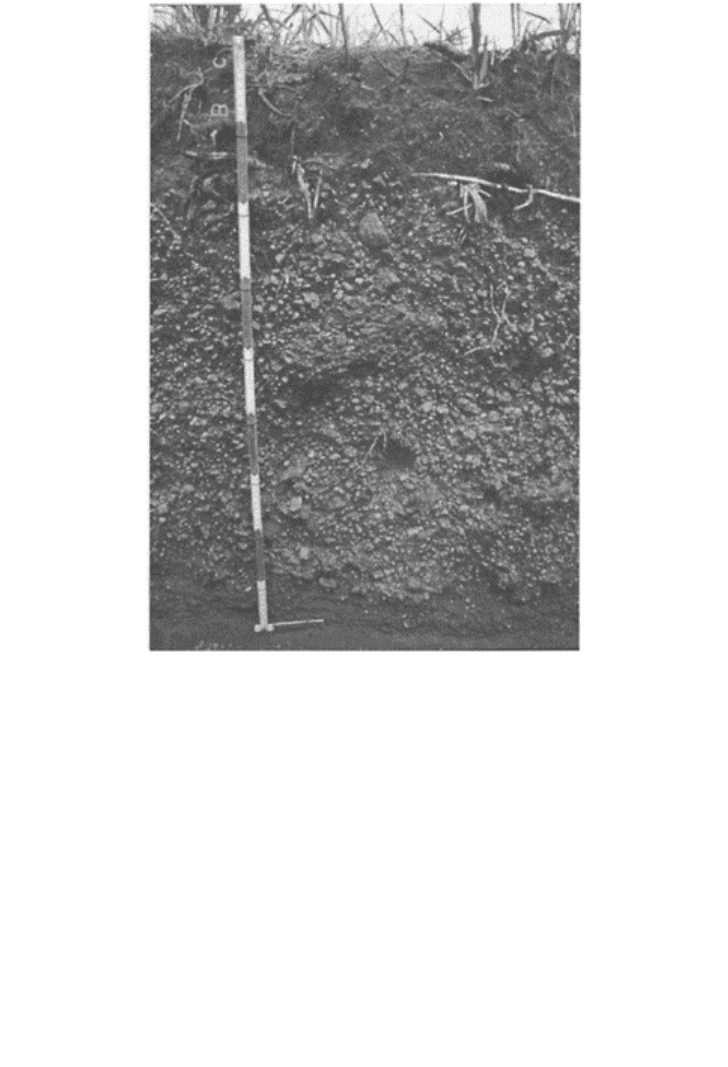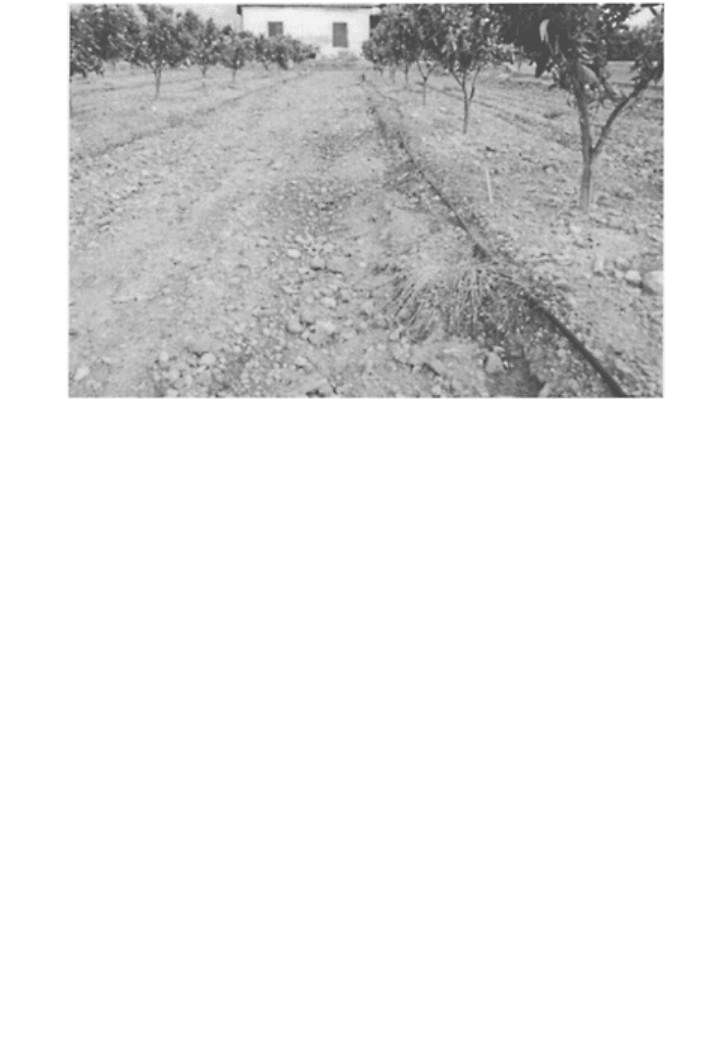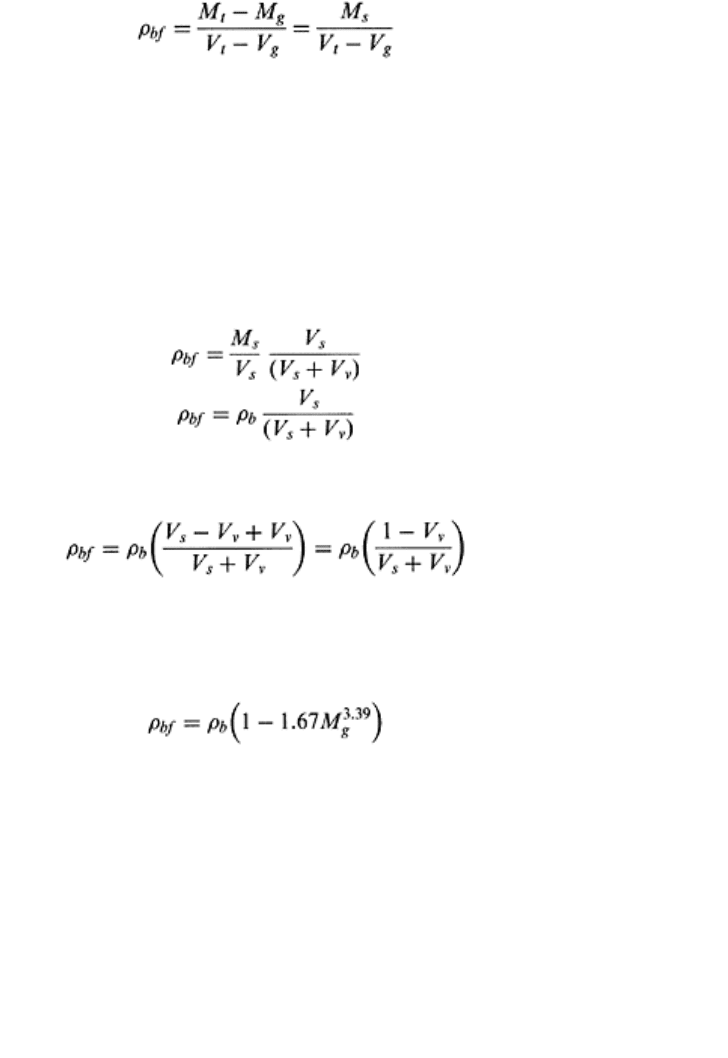Lal R., Shukla M.K. Principles of Soil Physics
Подождите немного. Документ загружается.


19
Physical Properties of Gravelly Soils
19.1 SKELETAL SOIL: CLASSIFICATION
Skeletal soils are those that contain coarse fragments including gravels, stones, or rocks
(Figs. 19.1 and 19.2). According to FAO (1977) classi-fication, the particles in a skeletal
soil are classified based on size as gravel (2–75 mm), stones (75–250 mm), and boulders
(>250mm). The Soil Survey Manual (Soil Survey Staff, 1951) classifies skeletal soils
according to the diameter of round, subround, angular, or irregular fragments into gravel,
pebbles, cobbles, stones, and boulders (Table 19.1a), as well as according to the length of
flat fragments as channer, flagstone, stone, and boulder (Table 19.1a). The upper limit of
sand content (2 mm) corresponds to the lower limit of coarse fragments. The pebbles,
cobbles, and stones are all in the range from 76 mm to 250 mm. The Soil Survey Staff
(1993) have classified the gravels in two major categories: (i) spherical, cubelike, or
equiaxial, and (ii) flat (Table 19.1b).
According to soil taxonomy, soil fragments are classified at family and series level
based on the particle size. The family particle size classes refer to whole soil including
coarse fragments and are different than USDA textural classes (soil particles <2mm).
Soils with more than 35% of coarse fragments

FIGURE 19.1 A gravelly soil in
western Nigeria with high gravel
concentration in the subsoil horizon.
are known as “skeletal” soils. Soils having large coarse fragments but very little fine
earth to fill interstices larger than 1 mm in diameter are known as “fragmental” soils. The
volume percentage of rock fragments is used in identifying and naming map units during
soil survey. If volume percentage of coarse fragments is less than 15% no special term is
used. For volume percentage of coarse fraction between 15% and 35%, the map unit
name includes the class name of rock as a modifier of textural class (for examples,
gravelly loam or cobbly loam). For volume percentage of rock fraction between 15% and
35%, the term “very” precedes the textural classification (e.g., very gravelly loam) and
for greater than 60% the term “extremely” (e.g., extremely cobbly loam).
Out of the recognized 12,620 soil series in United States, 2181 or 17% of the soil
families are those, which contain 35% or more coarse fragments. The loamy skeletal
particle size class contains about 1489, i.e., two-thirds of
Physical properties of gravelly soils 555

FIGURE 19.2 A gravelly soil in
Valencia, Spain, used for citrus
orchards with fertigation technology.
these families, and about 1136, or three-fourths, of them are in the western United States
(Miller and Guthrie, 1984). Coarse fragments are generally referred to as a combination
of gravels and stones, such as the particles in the size range of 2 mm and 250 mm
(Brakensiek and Rawls, 1994; Torri et al., 1994). This chapter specifically deals with
only those coarse particles, which are larger than 2 mm and smaller than 75 mm, and are
known as “gravels.” Thus, soils containing large proportion of gravels are called
“gravelly soils.”
19.2 GRAVELLY SOILS
The gravels in a soil are generally physically and chemically inert and can be from a
sedimentary, igneous, or metamorphic type of rock. Gravelly soils are wide spread in
semiarid and arid regions (Fig. 19.1). Regardless of their inert nature, gravels have a
strong impact on soil physical, mechanical, and hydrological properties. These properties
must be corrected for gravel content, and special procedures are needed to quantify the
physical properties of such soils.
19.2.1 Spatial Distribution of Gravels in Soils
Gravels are distributed in the soil profile including on the soil surface and deep inside the
soil profile. Therefore, concentrations of gravels occur both
Principles of soil physics 556

TABLE 19.1 Classification of Rock Fragments
According to the Shape and Size of Fragments
Rock fragment
a
Size (cm)
ACCORDING TO DIAMETER OF A REGULAR OR IRREGULAR FRAGMENT
Fine gravel 0.2–0.5
Medium gravel 0.5–2
Coarse gravel 2–7.6
Cobble 7.6–25
Stone 25–60
Boulder >60
ACCORDING TO THE LENGTH OF THE FLAT FRAGMENT
Channer 0.2–15
Flagstone 15–38
Stone 38–60
Boulder >60
Shape and size
b
Noun Adjective
SPHERICAL, CUBELIKE, OR EQUIAXIAL
2–75 mm diameter Pebbles Gravelly
2–5 mm diameter Fine Fine gravelly
5–20 mm diameter Medium Medium gravelly
20–75 mm diameter Coarse Coarse gravelly
75–250 mm diameter Cobbles Cobbly
250–600 mm diameter Stones Stony
> 600 mm diameter Boulders Bouldery
FLAT
2- 150 mm long Channers Channery
150–380 mm long Flagstones Flaggy
380–600 mm long Stones Stony
> 600 mm long Boulders Bouldery
Source:
a
Modified from Soil Survey manual (1981).
b
Adapted from USDA (1993).
vertically in soil profile and laterally in the surface. Concentration of gravels is generally
higher in surface than subsoil horizons (Nettleton et al., 1989; Parsens et al., 1992). The
Physical properties of gravelly soils 557

high concentration of gravels at the surface can occur as (i) removal of fine earth by wind
or water erosion, and (ii) upward migration of coarse fragment by freeze-thaw cycles, etc.
(Cooke et al., 1993). The gravel content of soil can have a high spatial variability in a
field (Childs and Flint, 1990; Webster, 1985).
19.2.2 Volumetric Gravel Content
The amount of gravels in the topsoil can be expressed by: (i) gravimetric content, (ii)
volumetric content, and (iii) coverage of the soil surface. Sieving and weighing the gravel
fraction provides the information on the gravimetric content. The sieved and air-dried
gravels can be immersed in a known volume of water and the net volume change (total
displacement) determines the volume of gravels to express the volumetric gravel content.
19.2.3 Effect of Gravels on Soil Physical and Hydrological Properties
Presence of gravels in the soil makes the determination of physical and hydrological
properties difficult. The mechanical analysis for particle size distribution on <2mm
fraction and assessment of the gross bulk density could lead to erroneous conclusions for
soils with high gravel content. Thus corrective methodologies for the determination of
physical properties of gravelly soils are needed and are outlined in Table 19.2 (Lal,
1979). Large gravel concentration at the soil surface or even partly incorporated in the
topsoil affect porosity, rainfall interception, moisture distribution, water infiltration,
overland flow, evaporation, and land use and productivity. Presence of gravels below the
soil surface also influences porosity, water infiltration, percolation, and runoff. Effects of
gravels on some soil physical and hydrological properties are discussed briefly in the
following section.
19.2.4 Structure
The gravels at the soil surface prevent sealing and crusting by reducing the impact of
raindrops on soil surface. They protect soil aggregates, reduce dispersion of soil
aggregates by raindrop impact, freeze-thaw cycles, etc., and improve soil structure. The
gravels below the soil surface can reduce compaction and bulk density and can either
support or improve the existing soil structure (Ravina and Magier, 1984).
19.2.5 Texture
The water and nutrient uptake zone in a soil is generally up to 60 cm, which is also the
zone where most of the plant roots exist. The variability in soil texture, which influences
the water holding capacity, root development, cation exchange capacity, and ease of
harvesting below ground crops (e.g., potato, cassava, yam, sweet potato, turmeric, etc.), is
also high in this depth range (i.e., 0 to 60 cm). Various textural classes are grouped
together and
Principles of soil physics 558

TABLE 19.2 Some Recommended Methods for
Determination of Physical Properties of Gravelly
Soils
No. Soil
property
Recommended methodology Remarks
1 Texture Hydrometer or pipette method
(thorough dispersion both mechanical
and chemical)
Determination of gravelly material
(>2mm) must be made
2 Bulk density Soil excavation Gravel correction and bulk density
of fine earth material should be
determined
3 Moisture
content
Neutron probe tensiometer Calibration before use for each
horizon
4 pF In situ measurement, measurements in
lab on large cores
The rock soil system should be
present in core
5 Aeration Sampling by diffusion tubes
6 Air
permeability
Air permeameter In situ
7 Erodibility Unit runoff plot under natural rainfall
conditions
Lab simulations are not
recommended
Source: Modified from Lal, 1979.
assigned a code number based upon the coarseness or fineness of a soil (Table 19.3)
(Mansfield, 1979).
19.2.6 Porosity
The porosity of soil varies spatially in general and when stones or fragments are present,
the variability increases because of the range and tortuosity associated with gravel
fragments (Tables 19.4 and 19.5). The bulk volume of gravelly soils is the sum of the
volume of gravels and volume of soil. The porosity of each of these fractions can be
measured. However, the total porosity of soil is the porosity of these two fractions plus
the space between the soil particles and gravels, which is difficult to measure. The space
between soil and large gravels often contains large pores or channels, which are also
known as macropores (Bevan and Germann, 1982). The increase in total porosity
associated with gravelly soils can be attributed to: (i) space between gravels is
incompletely filled by fine earth, (ii) the smaller particles
Physical properties of gravelly soils 559

TABLE 19.3 Grouping of Textural Classes
According to the Coarseness of Material
Textural class
a
Grade Code No.
CL, SC, C, SiC, SiCL Fine 1
L, SCL, SiL, Si Medium 2
S, LS, SL Coarse 3
CS, LcS, cSL Very coarse 3c
a
CLl is clayloam; SC is sandy clay; C is clay; SiC is silty clay; SiCL is silty clay loam; L is loam;
SCL is sandy clay loam; SiL is silty loam; Si is silt; S is sand; LS is loamy sand; SL is sandy loam;
CS is clayey sand; LcS is loam coarse sand; and cSL is coarse sandy loam.
Source: Modified from Mansfield, 1979.
TABLE 19.4 Soil Physical Properties: Total Bulk
Density (ρb), Volumetric Rock Fragment (V
v
),
Particle Density of Rock Fragments (ρ
pr
), Porosity
of Rock Fragments (f
r
), Bulk Density of Rock
Fragments (ρ
r
), and Available Water Content in
Rock Fragment (AWC
r
)
ρb V
v
ρpr fr ρr AWC
r
Parent material (Mg m
−3
) (%) (Mg m
−3
) (%) (Mg m
−3
) (%)
Granite 0.98–1.32 5.5–10.0 2.62–2.78 16.5–17.3 2.17–2.35 1.6–4.1
Metasediment 1.05–1.53 10.5–40.2 2.50–2.87 11.8–34.5 1.64–2.46 5.3–27.2
Pumice and ash 0.69–0.72 12.3–32.2 2.13–2.33 52.2–60.3 0.84–1.11 16.2–24.7
Basalt 1.42–1.65 40.8–55.7 2.60–2.66 23.3–37.1 1.75–2.14 21.1–36.3
Source: Modified from Flint and Childs, 1984.
TABLE 19.5 Porosity of Parent Material
Material Porosity (%)
Basalt 23–37
Granite 15–20
Metasediment 13–29
Pumice and ash 50–60
Tuff and breccia 40–60
Source: Modified from Flint and Childs, 1978.
Principles of soil physics 560

cannot pack as closely to the larger particle as they can with each other, (iii) the
differences in the behavior of fine earth and gravels during the process of wetting and
drying or freezing and thawing, and (iv) change in the nature of fine soil fraction in
presence of gravels (Poesen and Lavee, 1994; Stewart et al., 1970). Therefore, the total
porosity of soils containing gravel fractions is larger than without them. With increasing
gravel fraction, the decaying organic matter, water, and fertilizer inputs are all
concentrated on a decreasing mass of fine soil. The increase in organic matter content of
fine soil improves the soil structure and increases porosity (Childs and Flint, 1990;
Poesen and Lavee, 1994). The porosity of soil gravel fraction (f
g
) can be calculated as
follows
(19.1)
ρ
b
=ρ
bf
+V
g
(ρ
g
−ρ
bf
)
(19.2)
where ρ
b
is the overall bulk density of soil (including gravels); ρ
bf
is the bulk density of
soil without gravels, also known as bulk density of fine earth material; V
g
is volumetric
gravel fragments (as a fraction of total volume); and ρ
s
is the particle density of soil,
including gravel fraction.
19.2.7 Bulk Density
Two types of bulk density values are generally required for a soil containing gravels: total
bulk density of gravelly soil (ρ
b
) and bulk density of fine earth (ρ
b
f). The extra porosity
associated with the gravels in soil profile decreases the bulk density of the soil. In
general, as proportions of gravels increases the bulk density decreases (Stewart et al.,
1970; Torri et al., 1994). Some typical values of bulk density of gravels and other
particles are given in Tables 19.4 and 19.6. The bulk density of a gravelly soil is
corrected for
TABLE 19.6 Bulk Density of Different Fragments
Fragment Bulk density (Mg m
−3
) Reference
Basalt 1.95 Childs and Flint (1990)
Granite 2.17 Ingelmo et al. (1994)
Limestone 2.08 Alberto (1971)
Sandstone 2.56 Childs and Flint (1990)
Shale 2.07 Hanson and Blevins (1979)
Siltstone 1.97 Montagne et al. (1992)
Quartzite 2.43 Ingelmo et al. (1994)
stone content as follows:
Physical properties of gravelly soils 561

(19.3)
where ρ
bf
is the bulk density of fine earth or rock free soil, M
t
is the total mass of soil
including gravels, M
s
is the mass of fine earth or gravel-free soil, M
g
is the mass of
gravels, V
t
is the total volume of soil plus gravels, and V
g
is volume of gravels in V
t
. The
volume of soil (V
s
) occupied by mass M
s
and the volume of voids introduced by gravels
(V
v
) can replace the denominator (V
t
−V
g
) in Eq. (19.3) as follows:
V
t
−V
g
= V
s
+Vv
(19.4)
Transferring Eq. (19.4) into (19.3) and diving both numerator and denominator by V
s
yields
(19.5)
(19.6)
where ρf, is the bulk density of soil in the absence of gravels. Adding and subtracting the
volume of voids, V
v
by gravels in Eq. (19.6) results in:
(19.7)
The ratio (1−V
v
)/(V
s
+V
v
) largely depends on the gravel content, and its shape and size
(Torri et al., 1994). The ratio (1−V
v
)/(V
s
+V
v
) is replaced by a power function and an
empirical relationship can be used for calculating the bulk density of soil as follows
(Torri et al., 1994):
(19.8)
where M
g
is the gravimetric gravel content.
19.2.8 Water Retention
Skeletal fractions can hold substantial quantities of water, which are available for the
plant roots (Hanson and Blevins, 1979). The genetic or depositional layers increase water
retention in gravelly soils (Clothier et al., 1977). If the gravels are porous they can further
increase water retention depending upon their water holding capacity. The water is stored
between the contact points for rocks up to 3 cm. For large gravels (~7.5 cm) and cobbles
and rock fragments (>10cm), water can also be held as puddles on the surface. However,
the water release depends on the properties of fine earth in which they are embedded.
Some skeletal soil particles, which are in the range 0.2–7.5 cm, also weather. They are
Principles of soil physics 562

more porous and can absorb larger quantities of water per unit mass (Childs and Flint,
1990). The bulk water content on a volume basis for gravelly soil (θ) can be calculated
from gravimetric water content (w) (Table 19.7) as follows (Flint and Childs, 1984):
θ
f
=w
f
*ρ
bf
(19.9)
θ
g
=w
g
*ρ
g
(19.10)
θ=θ
f
*(1−V
v
)+θ
g
* V
v
(19.11)
where θ
f
and θ
g
are the volumetric water contents of fine earth and gravels, respectively,
w
y
and w
g
are the gravimetric water contents of fine earth and gravels, respectively, and
ρ
bf
and ρ
g
are bulk densities of fine earth and gravels, respectively.
The effects of gravels on water retention are usually linked to the existence of large
pores, which can develop as a consequence of packing or as cracks during drying and can
be observed at small matric suction.
TABLE 19.7 Average Gravimetric Moisture
Content at Saturation for Different Fragments
Fragment W
r
(%) Reference
Basalt 0.4 Gras and Monnier (1963)
Granite 0.4 Gras and Monnier (1963)
Limestone 5.2 Gras and Monnier (1963)
Sandstone 13.1 Gras and Monnier (1963)
Shale 34.0 Hanson and Blevins (1979)
Siltstone 12.3 Montagne et al. (1992)
The increase in gravel content up to about 40% increases the volume extracted at low
suction (Ravina and Magier, 1984). The water content at field capacity is directly related
to the porosity of the gravel content. In skeletal soils, the total available water can range
from 1.6 to 52.1 % (Table 19.4) (Flint and Childs, 1984). The volumetric soil water
content at −33 kPa is inversely related to percent coarse fragment by weight. However,
volumetric water content at − 1500 kPa is uncorrelated with gravimetric percent coarse
fragment (Petersen, 1968). For a soil containing gravels, the available water capacity
(AWC), which is the difference between water content at field capacity (FC) and wilting
point (WP), can be calculated as follows (Moormann et al., 1975):
(19.12)
where ρ
b
is overall bulk density of soil and gravels, ρ is the density of water, M
g
is the
mass of gravel, M
s
is the mass of fine earth, and z is thickness of soil horizon. The above
Physical properties of gravelly soils 563
